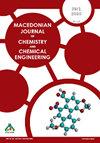响应面法优化刺荨麻叶中抗氧化剂的提取工艺
IF 1.1
4区 化学
Q3 CHEMISTRY, MULTIDISCIPLINARY
Macedonian Journal of Chemistry and Chemical Engineering
Pub Date : 2022-05-30
DOI:10.20450/mjcce.2022.2238
引用次数: 0
摘要
本研究旨在优化刺荨麻叶总黄酮的提取工艺参数。不同溶剂对总黄酮含量影响的比较表明,无论提取时间如何,甲醇水提物的总黄酮含量均高于乙醇水提物。因此,采用全因子设计和响应面法(RSM)来估计甲醇含量(50%、75%和100%)和提取时间(30、60和90分钟)对提取物总黄酮含量和抗氧化能力的影响。RSM分析表明,溶剂中甲醇含量显著影响总黄酮含量和FRAP(铁还原抗氧化能力测定)抗氧化能力,而提取时间对这两种反应均无显著影响。最大总黄酮含量的提取参数估计为69%的甲醇水溶液和67分钟,最大FRAP抗氧化能力的提取参数为65%的甲醇水混合物和83分钟。DPPH(2,2-二苯基-1-苦基肼基)的抗氧化能力不受萃取时间或溶剂中甲醇百分比的显著影响。本文章由计算机程序翻译,如有差异,请以英文原文为准。
Optimization of the extraction of antioxidants from stinging nettle leaf using response surface methodology
The aim of this study was to optimize the parameters of the extraction of total flavonoids from stinging nettle leaf. Comparison of the effects of different solvents on total flavonoid content showed that, regardless of extraction time, aqueous-methanolic extracts had higher total flavonoid content than aqueous-ethanolic extracts. So, full factorial design and response surface methodology (RSM) were employed to estimate the effects of methanol content (50, 75, and 100 %) and extraction time (30, 60, and 90 minutes) on total flavonoid content and antioxidant capacities of the extracts. RSM analysis showed that methanol content in the solvent influenced significantly total flavonoid content and FRAP (Ferric Reducing Antioxidant Power Assay) antioxidant capacity, while extraction time had no significant effect on either of the responses. Extraction parameters for maximal total flavonoid content were estimated to be 69 % aqueous-methanol and 67 min, and 65 % aqueous-methanol and 83 min for maximal FRAP antioxidant capacity. DPPH (2,2-diphenyl-1-picrylhydrazyl) antioxidant capacity was not significantly affected by extraction time or methanol percentage in the solvent.
求助全文
通过发布文献求助,成功后即可免费获取论文全文。
去求助
来源期刊
CiteScore
1.60
自引率
20.00%
发文量
14
审稿时长
>12 weeks
期刊介绍:
Macedonian Journal of Chemistry and Chemical Engineering (Maced. J. Chem. Chem. Eng.) is an official publication of the Society of Chemists and Technologists of Macedonia. It is a not-for-profit open acess journal published twice a year. The journal publishes original scientific papers, short communications, reviews and educational papers from all fields of chemistry, chemical engineering, food technology, biotechnology and material sciences, metallurgy and related fields. The papers published in the Journal are summarized in Chemical Abstracts.

 求助内容:
求助内容: 应助结果提醒方式:
应助结果提醒方式:


